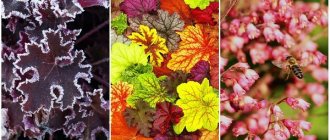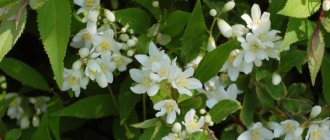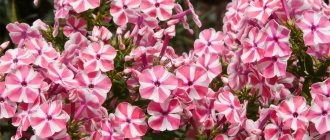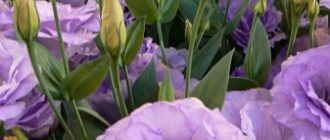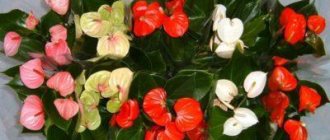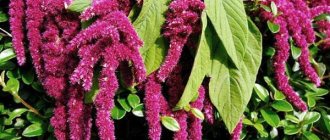Author: Elena N. https://floristics.info/ru/index.php?option=com_contact&view=contact&id=19 Category: Garden plants Published: February 26, 2019Last edits: January 13, 2021
- Rules of care
- Blood red heuchera (Heuchera sanguinea)
Heucheras are stunning beauties that you cannot pass by indifferently. Among them there are species that are striking in the color and color of their leaves, and there are also varieties with beautiful flowers, and everyone can find among them a plant to their liking. Thanks to the tireless work of breeders, heucheras have gained popularity all over the world. This plant is very popular among landscape designers. From our article you can find out what types and varieties of gherichera can be grown in the garden. You will also find answers to the following questions:
- how does heuchera reproduce?
- how to prepare a plant for wintering;
- how to protect hehera from diseases and pests.
Planting and caring for heuchera
- Planting: in spring, March or April.
- Flowering: from June to August.
- Lighting: bright diffused light, partial shade.
- Soil: moisture-absorbing, well-drained with a pH of 5.0-6.0.
- Watering: regular, as the soil dries - once every 2-3 days, in dry weather - twice a day.
- Feeding: from the second year before and after flowering with liquid mineral complexes in half the dose.
- Reproduction: seeds, dividing the bush, green cuttings.
- Pests: Weevils, leaf nematodes, butterfly caterpillars, snails and slugs.
- Diseases: gray rot, spotting, rust, powdery mildew.
Read more about growing heuchera below.
Heuchera (lat. Heuchera) is a genus of rhizomatous herbaceous perennials of the Saxifraga family, cultivated species and varieties of which are extremely in demand today in landscape design. Heuchera received its name in honor of Johann Heinrich von Heucher, a German botanist and doctor. Heuchera comes from the rocky regions of North America and is a compact bush up to half a meter tall, attracting the eye with its luxurious, exquisite leaves. Heuchera is a plant for gourmets, because during one growing season it can change the color of its leaves, more than once. No other crop is distinguished by such a palette of shades and so many options for their combinations as heuchera, and especially its modern variegated varieties.
Heuchera diseases and pests
As a rule, heucheras rarely get sick and practically do not suffer from pests. But with improper care, they can become infected with powdery mildew (which can be eliminated by spraying with fungicides - Agrolekar, Alirin-B, Topaz), rust and leaf spots (a 1% solution of Bordeaux mixture, as well as Chistotsvet, are effective against these ailments).
If there is excessive moisture, heuchera can be eaten by snails and slugs . To avoid this, carefully monitor watering, periodically collect pests by hand and, if necessary, place traps in the flower garden.
Plant spectacular heucheras on your site - and they will brighten even the most boring flower garden with bright colors. And if you want these flowers to decorate your home, grow them in containers. Heucheras grow well at home.
Botanical description
The dense bush of heuchera is formed by leathery, serrated leaves on long cuttings. The shape and color of the leaves is amazingly diverse: almost black, bright red, dark burgundy, amber, pink, purple, yellow, green and even silver leaves in all kinds of patterns and veins, specks and spots. The texture of the leaves is smooth, corrugated and curly. Heuchera blooms all summer, and even until frost, with small pink, white, cream or red bells collected in panicles. The heuchera fruit is a capsule in which seeds the size of a poppy seed ripen (about 20,000 seeds fit in 1 gram).
Heuchera has been used in landscape design for a long time. Designers divide heuchera varieties into two categories: decorative-deciduous, the ancestor of which was American heuchera, and decorative-flowering, such as red or blood-red heuchera.
- Muscari flowers - description
Description of heuchera for open ground
All types of heuchera existing in nature come from the American continent. Here, plants from the Saxifraga family, justifying their origin, settled across the rocky wastelands of the central and southern United States and some parts of Mexico. Most of the plants domesticated by humans are perennial decorative deciduous crops. According to the description, in the open ground, heuchera, which forms a lush rosette of split palmate leaves, changes their color depending on the season, miraculously transforming the corner of the garden allotted to it.
The appearance of foliage depends not only on the season, but also on the variety of heuchera. Thanks to two- or three-color leaves with jagged, smooth or corrugated edges, you can transform the most inconspicuous area.
The decorative effect is complemented by flowering that lasts all summer. The brightest inflorescences on erect peduncles are blood-red heuchera with small coral-colored corollas. In other species, the flowers are predominantly white or pinkish, collected in sparse paniculate inflorescences.
When to plant heuchera in open ground? What do you need to know about the nature of the plant and its preferences?
Features of cultivation
There are no obvious features or difficulties in growing heuchera, but this plant has characteristic features that will not hurt you to know. So:
- for decorative deciduous varieties of heuchera, if you do not have the goal of collecting seeds in the fall, it is better to remove the peduncle as soon as it appears: they grow much higher than the bush and have an unkempt appearance, which damages the decorative qualities of the plant;
- peduncles of decorative flowering varieties are removed immediately after the heuchera fades;
- Over time, the lower leaves on the bush fall off, and the heuchera looks untidy. You need to dig up the plant before flowering and transplant it together with the earthen ball into a deeper hole to hide the bald stem;
- at the beginning of growth, young heuchera leaves are bright and translucent, like flower petals, but as they mature, they thicken and darken;
- Heuchera goes well with primroses, daylilies, astilbe, bergenia and ornamental cereals.
In the photo: Variegated leaves of heuchera
Basic moments
In order for a garden shrub to grow healthy and delight you with rich colors, you need to worry about proper care for it. The plant prefers to grow in partial shade and does not tolerate bright rays of the sun.
Garden shrubs are widely used in landscape design. It can be planted not only in open soil, but also in a pot on a loggia or balcony.
Planting heuchera
When to plant
Heuchera is planted in March or April. Heuchera has good shade tolerance, so the best place for it is in the partial shade of other plants, where diffused light will fall on it. The best option is the eastern or western side, where direct sunlight falls only in the morning or evening. If this is not possible, and you have to plant it in the sun, then you need to provide the heuchera with regular and more abundant watering.
By the way, varieties with brightly colored leaves in an open sunny area become even brighter and more spectacular. And varieties with red leaves must grow in the sun, otherwise their leaves will remain green in the shade.
Heuchera is not picky when choosing soil; it can grow on any soil except acidic soil, the optimal pH is 5-6. Even a rocky area does not frighten the plant, because in nature, in its homeland, it covers the rocky shores of the Great Lakes. But the more fertile and loose the soil, the more attractive and lush the heuchera. Moisture capacity and, at the same time, good drainage of the soil on the site are of great importance. Heuchera does not tolerate stagnation of water in the roots.
How to plant
There are two methods of planting - seeds and seedlings. Heuchera seeds are simply sown in loose prepared soil and planted. But we remind you that seed propagation is not the best way, since it does not preserve the species and varietal characteristics of the mother plant, and at best, you will grow a simple heuchera with green leaves.
Hosta - planting and caring for the garden: everything you need to know
The seedling method is more reliable. Seedlings are grown in a greenhouse container and then planted in open ground to a depth of 3-4 cm at a distance of 20 cm from each other. The soil must be loose so that air can freely penetrate into the roots. Both heuchera from seeds in open ground and seedlings germinate in a month and a half.
General growing conditions
Lychnis perennial - planting and care in open ground
Heuchera requires little care. The most important thing is to choose the right place. It is better to plant the flower under the canopy of trees, since under the sun it will wither and require abundant and frequent watering. It is best to choose a place where there is some shade. However, you should not choose dense darkness, as this will cause the pattern on the leaves to disappear.
Important! Sufficient lighting is especially important when planting and caring for variegated heuchera species.
Heuchera care is easy. This perennial plant grows well in a summer cottage. It can be planted next to hostas, herbaceous plants, shrubs and coniferous species.
The flower in question is not picky about the composition of the soil. However, it will not be able to grow on some types of soil. What kind of soil does heuchera not like:
- land with excessively high acidity;
- there is a very high density of earth at the landing site;
- bad conditions if groundwater, melt or rainwater stagnates in the soil.
The plant blooms especially luxuriantly in loose soil, which maintains a normal amount of moisture.
Heuchera care
Rules of care
Growing heuchera is not difficult, and caring for heuchera will not tire you. By and large, she does not need any care. In the first year of the growing season, in the year of planting, the plant does not need feeding; in subsequent years, decorative flowering heuchera varieties need to be fed with a universal fertilizer for flowering plants, and decorative deciduous ones with complex fertilizers for deciduous plants, respectively.
The feeding time is before and after flowering, and the dose should be reduced by half compared to that recommended on the package.
In the photo: Heuchera planted in the ground
Watering the heuchera should be regular, as the soil dries out - once every two days, and it is better to forget to water the heuchera than to do it twice - excess moisture harms it. But on hot, dry days you will have to water the heuchera twice a day - early in the morning and in the evening. You need to pour water under the bush, carefully so that the splashes do not fall on the leaves, which may become covered with burn spots.
If you don’t want to have trouble with weeds and loosening the soil after watering, mulch the heuchera planting with peat in the spring.
Heuchera propagation
When the plant is 3-4 years old, its rosette may fall apart and you will see the exposed middle. This means that the time has come to divide the bush and plant its parts, thereby rejuvenating the heuchera. The best time for this method of propagation is May or early autumn. Divide the bush so that each division has 2-3 rosettes.
Roots that are too long need to be shortened, and those on which signs of rot are found should be cleaned of rot and the wounds dusted with charcoal powder.
- Levkoy: planting and care in open ground
Parts of the divided bush are planted in holes measuring 30x30 a little deeper than the mother plant was planted, at a distance of 25 cm from each other. After planting, it is advisable to water and mulch the area. Parts of the bush take root within a month. This method of propagating heuchera is called bush division.
Planting and caring for irises: advice from experienced gardeners
Heuchera also reproduces in another vegetative way - by cuttings. Heuchera cuttings are carried out in June or July: cuttings are cut from the mother bush as close to the soil surface as possible, but without rhizome fragments, divided into pieces of 4-6 cm, the lower sections are powdered with a root former, partially freed from leaves and rooted in a mixture of peat and sand in homemade greenhouses located in partial shade. Do not forget to ventilate the cuttings and moisten the soil in the containers. Rooting occurs in 3-4 weeks.
Pests and diseases
Heucheras get sick very rarely, and they are not afraid of pests, but sometimes they still suffer from powdery mildew, rust, gray rot and spotting. The cause of these ailments is excess fertilizer or stagnation of water in the roots of plants.
Heuchera can be treated with a fungicide to get rid of powdery mildew, which covers the leaves with a whitish coating. And spotting and rust can be defeated by spraying the heuchera twice a month with a solution of Bordeaux mixture.
In the photo: Beautiful heuchera leaves
Among the pests dangerous to heuchera are snails, slugs, weevils, caterpillars and leaf nematodes, which can be eliminated with special insecticides.
What kind of light does he like?
Different plant varieties have their own preferences for the degree of illumination. But if we consider the genus as a whole, then heuchera loves diffused light and partial shade.
- Bright variegated species need a little more light - 5-6 hours of direct sun in the morning or evening.
- Green leafy varieties contain more chlorophyll. They grow best in shade, but not too dense. For example, from low trees.
In a sunny area, heuchera grows slowly, burns out, and the leaves grow small. To reduce stress, when planting in the sun, plants are often watered and sprayed in the evening (up to 2 times a week). It is also recommended to mulch the soil to avoid overheating of the root system.
Types and varieties
The genus Heuchera has approximately 70 species. Many of them grow naturally in forests and woodlands of the mountainous regions of Mexico and the United States. Heuchera species are conventionally divided into mountain and forest. We will introduce you to the most popular species and varieties among gardeners, which are used in landscape design and for breeding new varieties.
Blood red heuchera (Heuchera sanguinea)
Belongs to mountain species. It has green leaves and bright red flowers. Americans call it the red bell. The leaves of Heuchera blood-red, forming a rosette, are much denser than those of other species, they are round and jagged. Some varieties of this species are distinguished by beautiful white or cream specks on the leaves. Peduncles reach a height of 50 cm. This species is cold-resistant, which is why it is so popular among our gardeners. The most famous varieties are Monet, Variegata, Hercules.
In the photo: Blood-red Heuchera (Heuchera sanguinea)
Heuchera villosa
It is distinguished by large leaves with a velvety surface and pubescent peduncles and cuttings, which is why it got its name. The Bronze Wave variety has the largest leaves, up to 20 cm in diameter, bronze color, and Rachel has not only flowers, but also peduncles of a soft pink color.
In the photo: Hairy Heuchera (Heuchera villosa)
Heuchera cylindrica
Also a mountain species, it not only has spectacular leaves, but also tall peduncles with a cloud of small flowers that seem to hover above the bush during flowering. This species is larger than others, and this attracted breeders who developed new varieties based on Heuchera cylindrical. Peduncles reach 90 cm in height; large flowers of white, pink, green and coral colors bloom on short stalks. The leaves are heart-shaped, round, green with a silver pattern or veins of contrasting color. Varieties: Greenfinch with greenish-cream flowers, Hyperion - a compact bush with a peduncle height of only 50cm and red-pink flowers.
In the photo: Heuchera cylindrica
Heuchera micrantha
According to many gardeners, this is the most spectacular of the heucheras. Its leaf, shaped like a maple, is covered with silver spots, and some naturally occurring specimens have purple leaves. The paniculate inflorescence on a peduncle 60 cm in height consists of small creamy-pink flowers with orange anthers. Among the popular varieties, the best known are Palace Purple with dark purple leaves, which is the best perennial plant of 1999, and Bressingham Bronze with bronze-brown leaves.
In the photo: Small-flowered Heuchera (Heuchera micrantha)
American Heuchera (Heuchera americana)
Growing on the shores of the Great Lakes. In the USA it is called mountain geranium. It attracts with its leaves, forming a rosette about 20 cm high. On the underside, the leaves are brown-lilac in color, heart-shaped, round, with long petioles. The panicles on peduncles 50-60 cm high consist of yellow-green flowers. Green Spice is one of the most beautiful varieties of American Heuchera with green leaves and contrasting silver spots on them. During the growing season, the leaves change shades of green from yellower to darker, the silver spots increase, and a purple hue appears around the veins.
- Blackleg - 4 conditions, the fulfillment of which will help you forget about this disease on seedlings forever
In the photo: American Heuchera (Heuchera americana)
Heuchera hybrida
This includes interspecific hybrids of American heuchera and blood-red heuchera with the participation of small-flowered heuchera. The flowers of this species resemble the flowers of the blood-red heuchera, but they are somewhat larger, as are the leaves with peduncles. White, coral, red or pink flowers bloom for more than two months. The leaf color is mostly green, but with contrasting veins and cream markings. The only drawback of these hybrids is that the flower stalks may fall due to strong wind and rain. Varieties: Cancan, Cappuccino, Beauty Color, Ruby Vale and others.
In the photo: Hybrid Heuchera (Heuchera hybrida)
Heuchera grossulariifolia
This plant is so cold-resistant that even after wintering in the garden in severe frost it can completely retain its leaves, and it is this rare quality that attracts both flower growers and breeders.
When to plant heuchera
The main criterion for sowing is the climate of the region. If you focus on the weather conditions of central Russia, then you can plant the plant in March. In regions with harsh winters, it is recommended to postpone this procedure until the end of the spring.
The main thing is that the soil in the area where it is planned to plant heuchera warms up not only on the surface, but also at a depth of 5 cm.
Best sowing dates according to the lunar calendar 2022: table
According to the lunar calendar, the best dates for sowing the seeds of this perennial plant are as follows:
| Month | Best dates |
| March | 7, 11, 16 |
| April | 7, 8, 12 |
| May | 8, 10, 17, 18 |
| June | 6, 11, 14, 15 |
| July | 3, 10, 12, 13, 15 |
Reproduction
There are 3 methods of dividing a plant:
- Cuttings . Use side shoots, which are removed after flowering. The shoots are cut off with part of the rosette. Next, they are planted in holes and covered with plastic film. Rooting occurs within 1-2 months.
- Seeds. The later the seeds are planted after collection, the worse they will germinate. The seed material is mixed with sand and placed in the soil, covering the top with a film. The next step is planting the plants in separate containers. In the spring they will need to be moved to open ground.
- Dividing the bush. After 3-4 years, the heuchera will require a mandatory transplant. The old bush is divided and transplanted to produce young plants. The bush is dug out of the bed, the root is cleaned of soil and rot. Divide into several parts, it is important that each has 1-2 sockets. A place is prepared for planting, the holes are filled with humus and the plant is planted.
The most suitable soil for the plant is neutral or slightly acidic, containing a large amount of organic matter. It is acceptable to grow in alkaline or acidic soil. The basis for cultivation can be peat, leaf humus, soil (garden, turf).
The best time to plant heuchera after winter is the beginning of spring. Plants that are 1-2 years old are planted in open ground.
Heuchera in landscape design
Don't be afraid to experiment with planting heuchera in your area. Like precious stones, heuchera will decorate any flower garden; no other flower crop has such a rich palette with an abundance of colors and shades.
A huge advantage of heuchera is its decorative effect throughout the growing season and ease of care. Heuchera is grown both in single plantings of the same species and in mixed ones, and is used as a perennial ground cover plant. Having a compact bush form, heuchera is an ideal companion for combination with other plants. This is a real find for those cases when you need to fill space in a flower garden or emphasize the advantages of another plant, or highlight the planting of coniferous plants.
Heuchera in landscape design
Heuchera does not lose its decorative shape with age, so it will ideally fit into flower beds of strict geometric shapes and disguise unsightly areas. Heuchera is suitable for creating alpine slides, rocky gardens, borders, decorating terraces and gazebos. It can be used to decorate garden sculptures, slides and fountains. Often used for planting in front flower beds.
In the first year after planting, heuchera will be difficult to appreciate its merits in landscape design - just planted, it will not yet become such a lush beauty, but already in the next season you will be able to enjoy the density of colors.

